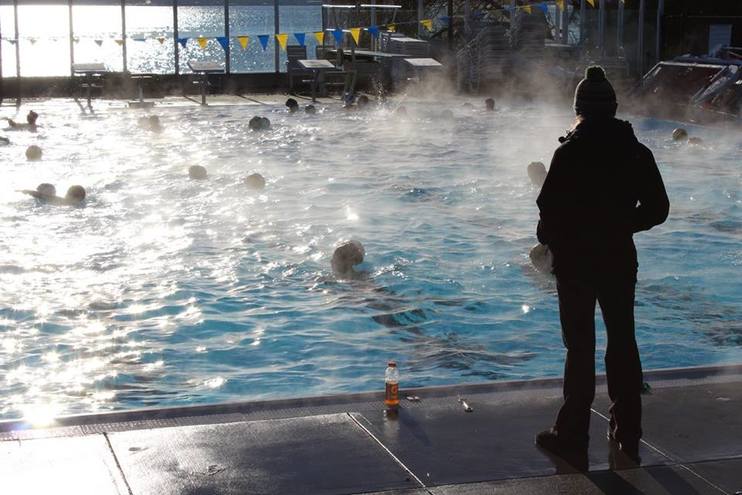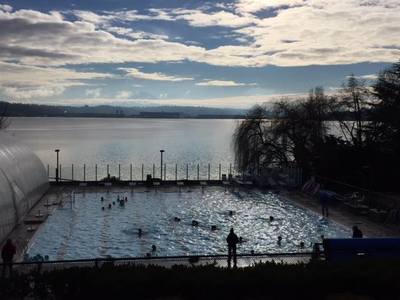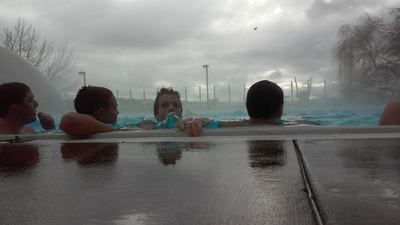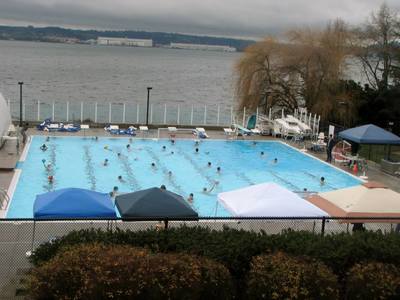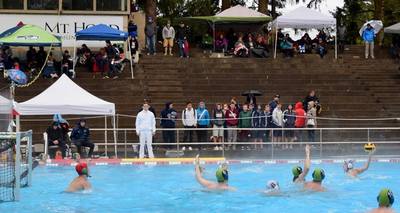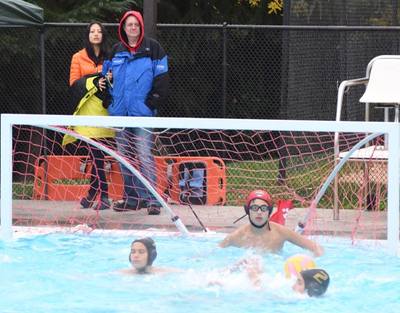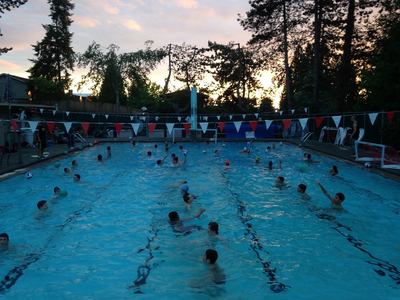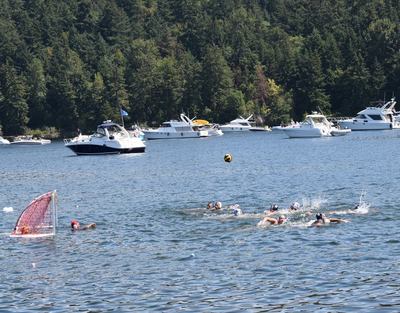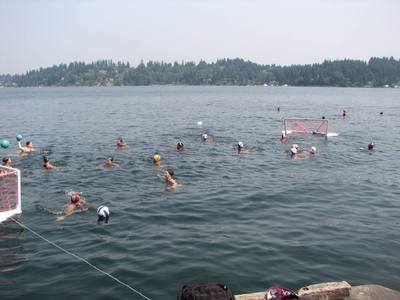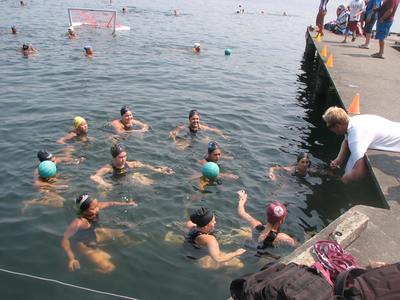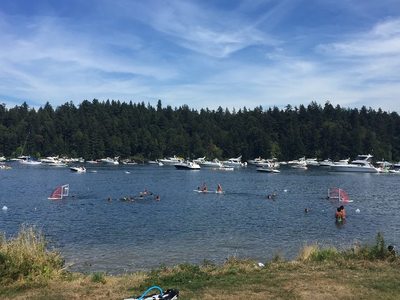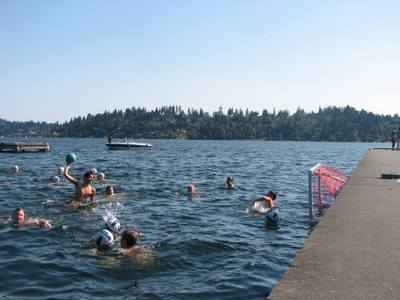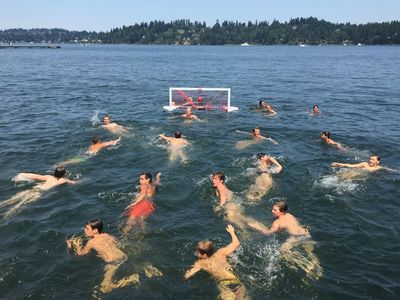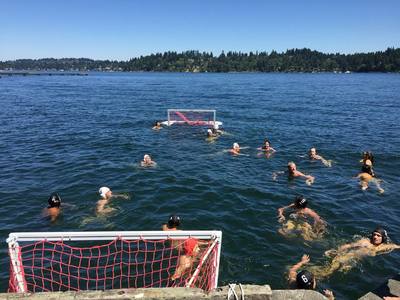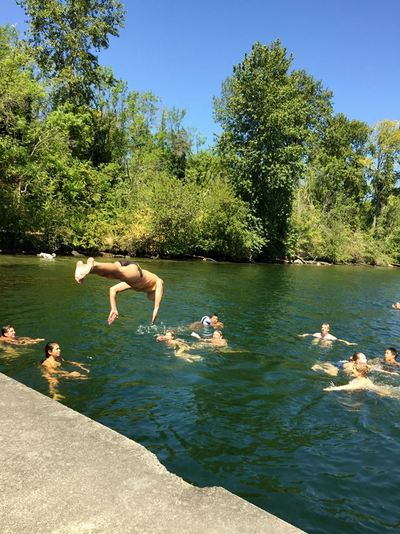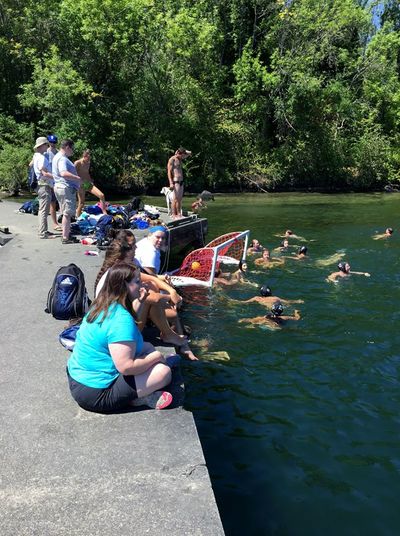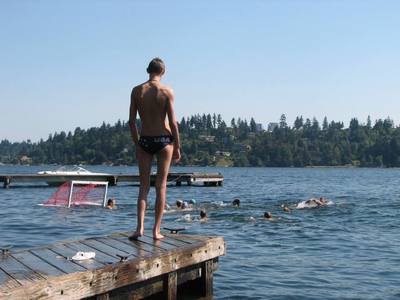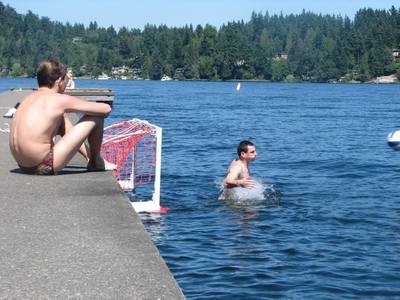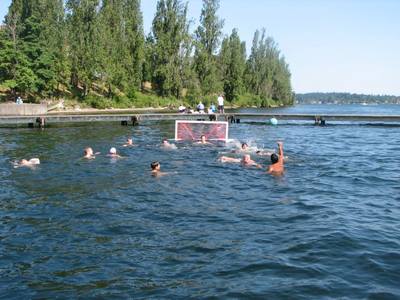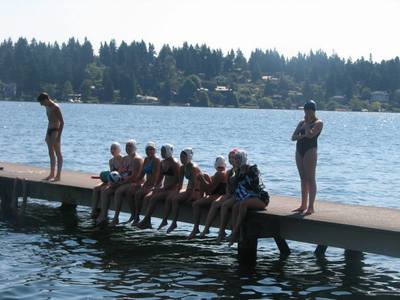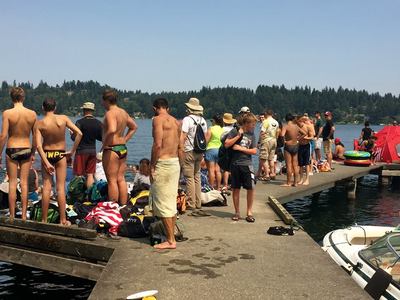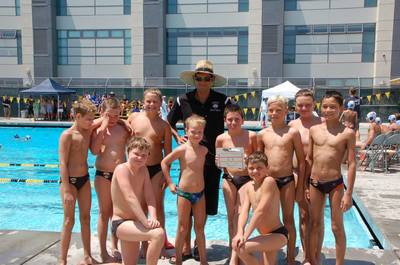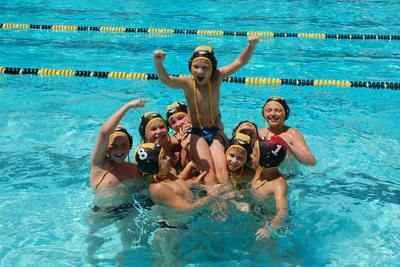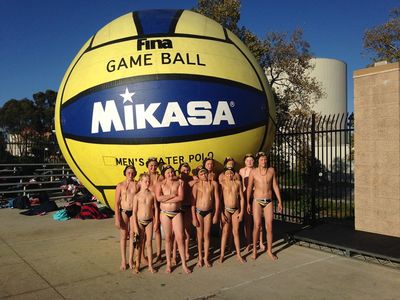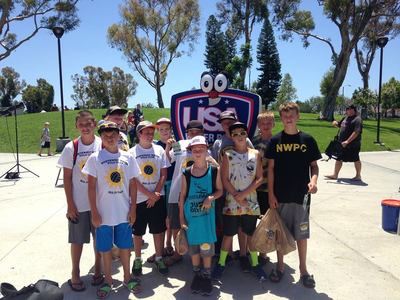The Current State and Growing Culture of Water Polo in Seattle
There are two different types of winter days in Seattle. One is when a slow and steady rain lingers throughout the day before giving way to a cold, clear night with vibrant stars overlooking a dampness that freezes over in the darkness. The other is when a short and gray day calmly threatens a rain that only comes at night with an inevitably angry downpour. Neither of these conditions lead to an evening where a sane person might find themselves outside, far from the comforts of their couch with a blanket and burning fire. In Seattle, water polo folk don’t care for what’s sane.
While most families settle down during these winter nights, water polo players from across the Seattle-Bellevue-Tacoma area in Washington brace for a typical outdoor practice. Parents ensure carpool plans are entact. The driver of the night fills up a thermal with tea or hot chocolate; sometimes coffee. Players ranging in age from eight to eighteen grab their minimal gear of a speedo and towel. No goggles. They arrive at practice wearing shorts and sweatshirts, despite the low temperatures, knowing they’ll lose the sweatshirt in a matter of minutes once dry-land begins. During the half hour dry-land session they’ll start with a short run before moving on to push-ups, crunches, burpees, lunges, planks, wall-sits, and minor lifting. The last practice before each tournament throughout the year calls for ultimate frisbee. Dry-land is optional, but teammates hold each other accountable, urging everyone to be there. The workload is valuable and designed by former college athletes with diverse backgrounds.
The coaches are bundled up. They wear at least two pairs of socks and waterproof shoes. Their feet will still be the first to suffer from the cold. On the crueler nights their faces are covered up during the swim sets, but as time goes on there is no break from giving vocal directions and blowing whistles. They aren’t just there to oversee practice; there is always a critique to be made for each pass, shot, and body position. It’s the little details that separate a good player from a great player. Great players train as creatures of habit. You have to leg up higher. Your elbow is too low. Shoot cross cage. Think about that wrist. Absorb the pass. Step into it. If it starts to snow, nothing changes.
The pool deck may be iced over but steam rises from the water. Athletes will be warm enough even if they don’t work as hard as they are encouraged to. Devoted parents of the younger players watch from a distance, satisfied with the discipline enforced by the coaching staff. Veteran parents enjoy socializing in the parking lot with each other before making runs to Starbucks, confident their kids are left in good hands.
This is the culture of the Northwest Water Polo Club.
Parents of the program have seen good times and bad. Years ago, the only water polo program in the area was the Rain City Water Polo Club. Behind the scenes differences caused the club’s director, John Jacobson, to part ways with the program and create the Northwest Water Polo Club. The main issue being that he encouraged attendance, giving priority playing time to players with the best attendance while the Rain City board members preferred he field a lineup with the best available athletes at any given tournament. John could not put confidence in players that weren’t frequently at practice and prior tournaments. He couldn’t trust their decision-making as a supplement to his system.
NWPC, sporting a black and yellow color scheme, could have initially been defined as a rag-tag gang led by a handful of John’s most loyal players, accompanied by newer players of various athletic abilities. These players all participated as one group, all going through the same workouts led by just John and one of his coaches that followed him from Rain City. The players and parents of those who left Rain City couldn’t imagine anybody other than John leading the charge. It wouldn’t be easy though as they knew Rain City was populated by athletes formerly trained by his coaching.
There could have been various reasons some players decided to stay at Rain City. It was an easy choice for those who didn’t want to go to every practice but still play in every game. Perhaps others just wanted to finish their last couple years under the same team. Or might have felt as though they’d put in their work, developed their skill, and were now entitled to a downhill trip with less discipline for their remaining years. Or maybe they simply preferred the pools that Rain City practiced in.
John works his players hard. He disciplines them. He keeps them accountable while teaching them to create a culture where they keep each other accountable. He wants players that devote themselves to being water polo players above all (with the exception of academics); athletes who want the identity of being a water polo player. Over the years he has seen too many kids from Washington use water polo as a secondary activity or resume booster. Something to do on the side after band, baseball, or swimming obligations are fulfilled.
Those who followed John to NWPC did so because they were open to the challenge of playing under him. They knew he yelled at them only to make them better. When he worked them hard it prepared them for the expectation of being nationally competitive with players from areas where water polo is more of a priority. They are open to punishment sets and know they might have to restart a swim set at any given moment. They know they do this to create good habits and accountability. They also develop enhanced listening skills, and learn there are team-wide consequences to selfish actions. If one player swims with his or her face in the water during head-up swimming, everybody restarts. John doesn’t coach to win. He coaches to prepare players for the opportunity to have a successful college career and furthermore prepare them for life.
NWPC players had an uphill battle from the start. Because of the lower numbers of a startup program, all athletes had to practice as one group. However, with a variety of experience and skill level, practices had to be balanced in a way to develop all players. The teams were somewhat handicapped in games having to play against their former Rain City teammates. Their friends. And in some unfortunate situations—their former friends. Tensions grew between parents of the opposing clubs; words were spoken, rumors spread.
While there were a lot of conflicting opinions about John’s coaching style, word of mouth eventually spread in his favor. As families of new players explored options, the eventual results of youth development would prove what the veteran parents of NWPC vouched, and it became clear that young, inexperienced players were developing at a fast rate under John’s guidance. He has always been upfront about his expectations, giving new players the opportunity to participate in free trials, and cutting them enough slack to give them time to adapt to a disciplined atmosphere. Slowly, Northwest grew in numbers. A new player or two for each age group each session made big impacts on the entire program, and soon practices could be split up by age and level of play. By the end of Northwest’s first year, the program would send three age groups to the Junior Olympics, including the only 12U Boys team from their entire zone (consisting of Oregon, Washington, Idaho, and Hawaii).
For the following year, an exodus of high school girls from Rain City came to Northwest to start up a woman’s team under John. He brought in more coaches, and was able to provide broader resources and experiences for his players, who began thriving at all the local tournaments. However, as the Northwest Water Polo Club has grown towards a dynasty over the past five years, why hasn’t water polo grown as a sport in the Seattle area?
Similar to other non-Californian states, water polo is not a mainstream sport in Washington. It isn’t necessarily a "cool" sport to play. Those who are naturally athletic and enjoy water polo can’t give the needed dedication because of other athletic commitments. Those who haven’t found success in other sports give water polo a try as a last resort. While NWPC, along with Rain City, and other clubs in the area that are all yearlong programs with the aspirations of going to the Junior Olympics, most local players haven’t considered playing yearlong. They only want to gear up for the Junior Olympics once summer begins and be able to say they played in the biggest youth tournament in the country that water polo has to offer. This is a frustration that all clubs in the Pacific Northwest—from Oregon to Vancouver—can relate to. A frustration that is hopefully disappearing.
John wants to change the water polo culture in the Seattle area by giving his players the opportunity to become water polo fiends. He wants them to accept water polo as their identity. All he wants is for seven devoted players to commit to each other and his system, willing to show up for everything offered on a year round basis. He needs seven hungry players to seek success on their own, but doesn’t dismiss players of lesser levels or commitments. If an athlete of any ability wants to give water polo a try, he or she serves as an opportunity for John to develop them into a valuable long term project as long as the player is willing to go all in.
John gives each and every player equal opportunity. He doesn’t care about athleticism, he cares about attendance and building chemistry. If you show up for every practice and game, he will believe in you. If you are an exceptional athlete that only shows up here or there, he knows he cannot count on you in clutch moments of games that have been discussed and practiced many times over in your absence. Water polo is not a one man game. He can’t count on a Captain America ripping shots from half court. He believes in chemistry, proper training, and sticking to the system. It’s not about money, athleticism, or potential, it’s about dedication. It’s about wanting that water polo identity.
John schedules as many local games as possible but knows the local competition isn’t strong enough. He sets up a training trip to California each year, giving his players the opportunity to practice and scrimmage with clubs where water polo is extremely popular. He enters his players in tournaments such as the Left Coast tournament and the Holiday Invite in East Los Angeles, among others. In addition, he has created strong connections with Canadian clubs, giving his players the opportunity to participate in International play. He goes out of his way to schedule clinics and talks with everybody from Olympians to nutritionists and current high-level collegiate athletes, as well as acquaintances from non-athletic realms to help generally motivate his players in life. He has used his resources to help create personalized motivational and strength and conditioning plans for players that strive to go the extra mile. The ultimate goal for his program is success in the Junior Olympics, which is something he is familiar with as the former goalie of a team that found the best result in state history.
In the process of striving for strong results, John knows that fun has to be balanced with the hard work and intense coaching. The last practice of each session is dedicated to fun; enjoyed by the athletes as they participate in relays, games, and other laughs. On holiday weekends he schedules casual meet ups for anybody in the local water polo community, including the famous “Turkey Tread” taking place the day after Thanksgiving each year. He recently associated Masters players into his program, letting former athletes of any local affiliation scrimmage each other and his high school players once a week. There has been enough interest to field three separate Master teams during these scrimmages, and to sign up an official Masters team for registered tournaments. Players of all ages are able to meet and play with the Masters over the summer months during Lake Polo; the growing sensation in the area.
Water polo players in Seattle battle all sorts of weather throughout the year. Rain, ice, snow, fog, gray mornings, and hot nights. The few short summer months of picturesque weather in the Pacific Northwest are embraced and remembered. With that comes the lake polo. What started out as a few coaches and handful of players dropping a floating cage into Lake Washington and tying it to a dock to play the shooting game “Five Alive” has developed into frequent high-volume festivities.
Scrimmages are organized, sometimes three on three, somethings ten on ten, or eight on twelve, or girls only, or parents only, or coaches against a seemingly endless army of kids. It doesn’t matter who plays and what the numbers are because it’s all pure fun. Friends, family members, and amateurs are all invited to play. Courses are set up by anchoring floating goals with weights and creating boundaries with rope and empty floating milk jugs. Barbecues, ultimate frisbee, card games, and the tie-dying of team t-shirts accompany lake polo events.
For the upcoming summer of 2017 a lake polo tournament of 3 on 3 (plus a goalie) will be offered as an official part of Seattle’s Sea Fair weekend. The tournament will tie the sport to the hydro-boat races, Blue Angel flyovers, musical festivities, and other events that take part annually in the most famous summer weekend of Seattle when nearly every Seattleite hangs out on the water. As the Northwest Water Polo Club will host this tournament, conveniently taking place just after the Junior Olympics, water polo will hopefully garner mainstream attention as a sport in the Seattle area.
Water polo is generally introduced to Seattle area kids at a young age in the selective country club community, but even then, only to a minor extent. After a long summer swim season, clubs field a water polo team for just a few weeks during the month of August. Traditionally, water polo is merely considered an extra activity after swim season ends, but suffers the loss of potential athletes due to August being a vacation month for most of the country club families. As soon as swim season is over, they take off. Frequently, teams won’t have enough players to field a full lineup for each age group and have to forfeit games. Rarely will the same players be at a game two weeks in a row, making it impossible to build chemistry and compete to a team’s full potential.
There are a lot of young kids with an enormous amount of natural talent that seem to enjoy the sport, but are only able to participate in a week’s worth of practices, and at best, a handful of games. While they may enjoy it, this is simply not enough time to fall in love with the game. Most of the players that excel in the country club league go back to other sports come fall time, and put off water polo until the following summer. They can go on playing one month at a time for years before considering the sport as a focused priority. Most of them don’t even know that year round club water polo is an option. By the time they do, they are so far behind the longtime year round athletes that they feel overwhelmed and just want to go back to playing summer league where the competition is minimal.
However, again, John Jacobson aims to change that mentality. With his growing coaching staff, and alumni players returning home to coach for the summer, the presence of NWPC is ever-growing, and more young athletes are giving water polo a try at the next level; willing to play the sport outside of the month of August. Marketing the sport is something that helps NWPC stand out from other clubs. They consistently update their Facebook page, while adding twitter and Instagram posts, seeking new ways to garner attention, such as profiling dedicated individual players or highlighting International headlines. With the exposure, friends of the current athletes tune in and become aware of the sport, and are willing to give it a try without formerly being exposed to the country club league.
Furthermore, various high schools in the greater Seattle area have added water polo to their Athletic Departments, helping grow the league that extends further south to Tacoma. Many players initially want to play year round club to get better for high school, but then realize that club water polo is more competitive than high school, and offers more opportunity. The key however, is to attract athletes at a younger age, so they can grow to be competitive with the California players. As John has long envisioned, the growth of water polo as a sport in the Seattle area has begun snowballing, but still hasn’t tapped into its full potential.
Anybody related to the water polo community across the United States knows that California is the Mecca of the sport. However, wherever they may be from—Chicago, Connecticut, Florida, Pennsylvania, Ohio, Washington, Tennessee—they can easily relate to others from the community. The water polo community is relatively small and tight-knit, but passionate. Extremely passionate. Those serious about the sport, whether they are a coach, player, parent, or significant other, never let the sport slip from the grips of their mind. While John has helped make strides in Washington, there are others important to their own local communities; developing athletes not just as players, but well-rounded members of society. Anytime a water polo player decides to introduce a friend to the sport, or a parent is willing to support their child for a tournament, or an ex-player mentors younger ones, or a current coach schedules a fun event; it all gives back to the water polo community. As big as water polo is in California, there is so much opportunity for the sport to grow in other areas of the country.
With the amount of players under John’s system that have found success in the ODP (USA developmental program) and collegiate levels in recent years, it just goes to show that one person can make a difference. One former player can return home, or relocate elsewhere, with water polo on their mind and put forth the effort to grow the love of the game. It may not be overnight, and it may take patience, but anyone who has played the game can’t deny what the sport has done for them and their development into the person they’ve become. To spread the water polo culture is a privilege.
There are a lot of young kids with an enormous amount of natural talent that seem to enjoy the sport, but are only able to participate in a week’s worth of practices, and at best, a handful of games. While they may enjoy it, this is simply not enough time to fall in love with the game. Most of the players that excel in the country club league go back to other sports come fall time, and put off water polo until the following summer. They can go on playing one month at a time for years before considering the sport as a focused priority. Most of them don’t even know that year round club water polo is an option. By the time they do, they are so far behind the longtime year round athletes that they feel overwhelmed and just want to go back to playing summer league where the competition is minimal.
However, again, John Jacobson aims to change that mentality. With his growing coaching staff, and alumni players returning home to coach for the summer, the presence of NWPC is ever-growing, and more young athletes are giving water polo a try at the next level; willing to play the sport outside of the month of August. Marketing the sport is something that helps NWPC stand out from other clubs. They consistently update their Facebook page, while adding twitter and Instagram posts, seeking new ways to garner attention, such as profiling dedicated individual players or highlighting International headlines. With the exposure, friends of the current athletes tune in and become aware of the sport, and are willing to give it a try without formerly being exposed to the country club league.
Furthermore, various high schools in the greater Seattle area have added water polo to their Athletic Departments, helping grow the league that extends further south to Tacoma. Many players initially want to play year round club to get better for high school, but then realize that club water polo is more competitive than high school, and offers more opportunity. The key however, is to attract athletes at a younger age, so they can grow to be competitive with the California players. As John has long envisioned, the growth of water polo as a sport in the Seattle area has begun snowballing, but still hasn’t tapped into its full potential.
Anybody related to the water polo community across the United States knows that California is the Mecca of the sport. However, wherever they may be from—Chicago, Connecticut, Florida, Pennsylvania, Ohio, Washington, Tennessee—they can easily relate to others from the community. The water polo community is relatively small and tight-knit, but passionate. Extremely passionate. Those serious about the sport, whether they are a coach, player, parent, or significant other, never let the sport slip from the grips of their mind. While John has helped make strides in Washington, there are others important to their own local communities; developing athletes not just as players, but well-rounded members of society. Anytime a water polo player decides to introduce a friend to the sport, or a parent is willing to support their child for a tournament, or an ex-player mentors younger ones, or a current coach schedules a fun event; it all gives back to the water polo community. As big as water polo is in California, there is so much opportunity for the sport to grow in other areas of the country.
With the amount of players under John’s system that have found success in the ODP (USA developmental program) and collegiate levels in recent years, it just goes to show that one person can make a difference. One former player can return home, or relocate elsewhere, with water polo on their mind and put forth the effort to grow the love of the game. It may not be overnight, and it may take patience, but anyone who has played the game can’t deny what the sport has done for them and their development into the person they’ve become. To spread the water polo culture is a privilege.
